The Influence of Noise Floor on the Measurement of Laser Linewidth Using Short-Delay-Length Self-Heterodyne/Homodyne Techniques
Abstract
:1. Introduction
2. Materials and Methods
3. Experimental Results and Analysis
4. Avoidance of Noise Floor Effects
4.1. Using a Delayed Self-Heterodyne Setup
4.2. Making Use of the Extrema Closest to the Center Frequency
4.3. Increasing the Injected Laser Power or Using an Amplifier
4.4. Tailoring the Length of Delay Fiber
5. Conclusions
Author Contributions
Funding
Data Availability Statement
Conflicts of Interest
References
- Bai, Z.; Zhao, Z.; Tian, M.; Jin, D.; Pang, Y.; Li, S.; Yan, X.; Wang, Y.; Lu, Z. A comprehensive review on the development and applications of narrow-linewidth lasers. Micro. Opt. Technol. Lett. 2021, 1–12. [Google Scholar] [CrossRef]
- Bloom, B.J.; Nicholson, T.L.; Williams, J.R.; Campbell, S.L.; Bishof, M.; Zhang, X.; Zhang, W.; Bromley, S.L.; Ye, J. An Optical Lattice Clock with Accuracy and Stability at the 10−18 Level. Nature 2014, 506, 71–75. [Google Scholar] [CrossRef] [PubMed]
- Bai, Z.; Williams, R.J.; Kitzler, O.; Sarang, S.; Spence, D.J.; Wang, Y.; Lu, Z.; Mildren, R.P. Diamond Brillouin Laser in the Visible. APL Photon. 2020, 5, 031301. [Google Scholar] [CrossRef]
- Chen, H.; Bai, Z.; Yang, X.; Ding, J.; Qi, Y.; Yan, B.; Wang, Y.; Lu, Z.; Mildren, R.P. Enhanced Stimulated Brillouin Scattering Utilizing Raman Conversion in Diamond. Appl. Phys. Lett. 2022, 120, 181103. [Google Scholar] [CrossRef]
- Kita, T.; Tang, R.; Yamada, H. Narrow Spectral Linewidth Silicon Photonic Wavelength Tunable Laser Diode for Digital Coherent Communication System. IEEE J. Sel. Top. Quantum Electron. 2016, 22, 23–34. [Google Scholar] [CrossRef]
- Qi, Y.; Yang, S.; Wang, J.; Li, L.; Bai, Z.; Wang, Y.; Lv, Z. Recent advance of emerging low-dimensional materials for vector soliton generation in fiber lasers. Mater. Today Phys. 2022, 23, 100622. [Google Scholar] [CrossRef]
- Hostetler, C.A.; Behrenfeld, M.J.; Hu, Y.; Hair, J.W.; Schulien, J.A. Spaceborne Lidar in the Study of Marine Systems. Annu. Rev. Mar. Sci. 2018, 10, 121–147. [Google Scholar] [CrossRef]
- Schawlow, A.L.; Townes, C.H. Infrared and Optical Masers. Phys. Rev. 1958, 112, 1940–1949. [Google Scholar] [CrossRef]
- Renk, K.F. Basics of Laser Physics; Springer: Berlin/Heidelberg, Germany, 2012. [Google Scholar]
- Scott, R.; Langrock, C.; Kolner, B. High-Dynamic-Range Laser Amplitude and Phase Noise Measurement Techniques. IEEE J. Sel. Top. Quantum Electron. 2001, 7, 641–655. [Google Scholar] [CrossRef]
- Bai, Z.; Zhao, Z.; Qi, Y.; Ding, J.; Li, S.; Yan, X.; Wang, Y.; Lu, Z. Narrow-Linewidth Laser Linewidth Measurement Technology. Front. Phys. 2021, 9, 768165. [Google Scholar] [CrossRef]
- Liang, W.; Ilchenko, V.S.; Eliyahu, D.; Savchenkov, A.A.; Matsko, A.B.; Seidel, D.; Maleki, L. Ultralow Noise Miniature External Cavity Semiconductor Laser. Nat. Commun. 2015, 6, 7371. [Google Scholar] [CrossRef] [PubMed]
- Kessler, T.; Hagemann, C.; Grebing, C.; Legero, T.; Sterr, U.; Riehle, F. A Sub-40-mHz-linewidth Laser Based on a Silicon Single-crystal Optical Cavity. Nat. Photon. 2012, 6, 687–692. [Google Scholar] [CrossRef]
- Zhang, Y.; Zhong, K.; Zhou, X.; Tsang, H.K. Broadband high-Q multimode silicon concentric racetrack resonators for widely tunable Raman lasers. Nat. Commun. 2022, 13, 3534. [Google Scholar] [CrossRef]
- Okoshi, T.; Kikuchi, K.; Nakayama, A. Novel Method for High Resolution Measurement of Laser Output Spectrum. Electron. Lett. 1980, 16, 630–631. [Google Scholar] [CrossRef]
- Otterstrom, N.T.; Behunin, R.O.; Kittlaus, E.A.; Wang, Z.; Rakich, P.T. A Silicon Brillouin Laser. Science 2018, 360, 1113–1116. [Google Scholar] [CrossRef] [PubMed]
- Gundavarapu, S.; Brodnik, G.M.; Puckett, M.; Huffman, T.; Bose, D.; Behunin, R.; Wu, J.; Qiu, T.; Pinho, C.; Chauhan, N. Sub-Hertz Fundamental Linewidth Photonic Integrated Brillouin Laser. Nat. Photon. 2019, 13, 60–67. [Google Scholar] [CrossRef]
- Chauhan, N.; Isichenko, A.; Liu, K.; Wang, J.; Zhao, Q.; Behunin, R.O.; Rakich, P.T.; Jayich, A.M.; Fertig, C.; Hoyt, C.W. Visible Light Photonic Integrated Brillouin Laser. Nat. Commun. 2021, 12, 4685. [Google Scholar] [CrossRef]
- Li, Y.; Fu, Z.; Zhu, L.; Fang, J.; Zhu, H.; Zhong, J.; Xu, P.; Chen, X.; Wang, J.; Zhan, M. Laser Frequency Noise Measurement Using an Envelope-Ratio Method Based on a Delayed Self-Heterodyne Interferometer. Opt. Commun. 2019, 435, 244–250. [Google Scholar] [CrossRef]
- Ma, W.; Xiong, B.; Sun, C.; Ke, X.; Hao, Z.; Wang, L.; Wang, J.; Han, Y.; Li, H.; Luo, Y. Laser Frequency Noise Characterization by Self-Heterodyne with Both Long and Short Delay. Appl. Opt. 2019, 58, 3555–3563. [Google Scholar] [CrossRef] [PubMed]
- Fang, Z.; Cai, H.; Chen, G.; Qu, R. (Eds.) Erratum to: Single Frequency Semiconductor Lasers. In Single Frequency Semiconductor Lasers; Optical and Fiber Communications Reports; Springer: Singapore, 2017; p. E1. ISBN 978-981-10-5257-6. [Google Scholar]
- Scully, M.O.; Lamb, W.E. Quantum Theory of an Optical Maser. I. General Theory. Phys. Rev. 1967, 159, 208–226. [Google Scholar] [CrossRef]
- Richter, L.; Mandelberg, H.; Kruger, M.; McGrath, P. Linewidth Determination from Self-Heterodyne Measurements with Subcoherence Delay Times. IEEE J. Quantum Electron. 1986, 22, 2070–2074. [Google Scholar] [CrossRef]
- Mercer, L.B. 1/f Frequency Noise Effects on Self-Heterodyne Linewidth Measurements. J. Lightwave Technol. 1991, 9, 485–493. [Google Scholar] [CrossRef]
- Chen, M.; Meng, Z.; Wang, J.; Chen, W. Ultra-Narrow Linewidth Measurement Based on Voigt Profile Fitting. Opt. Express 2015, 23, 6803–6808. [Google Scholar] [CrossRef]
- Ludvigsen, H.; Tossavainen, M.; Kaivola, M. Laser Linewidth Measurements Using Self-Homodyne Detection with Short Delay. Opt. Commun. 1998, 155, 180–186. [Google Scholar] [CrossRef]
- Xue, M.; Zhao, J. Laser Linewidth Measurement Based on Long and Short Delay Fiber Combination. Opt. Express 2021, 29, 27118–27126. [Google Scholar] [CrossRef] [PubMed]
- He, Y.; Hu, S.; Liang, S.; Li, Y. High-Precision Narrow Laser Linewidth Measurement Based on Coherent Envelope Demodulation. Opt. Fiber Technol. 2019, 50, 200–205. [Google Scholar] [CrossRef]
- Huang, S.; Wan, M.; Wu, J.; Lu, D.; Zhang, B.; Zheng, Y.; Liu, C.; Fang, X. Precise Laser Linewidth Measurement by Feature Extraction with Short-Delay Self-Homodyne. Appl. Opt. 2022, 61, 1791–1796. [Google Scholar] [CrossRef] [PubMed]
- Huang, S.; Zhu, T.; Cao, Z.; Liu, M.; Deng, M.; Liu, J.; Li, X. Laser Linewidth Measurement Based on Amplitude Difference Comparison of Coherent Envelope. IEEE Photon. Technol. Lett. 2016, 28, 759–762. [Google Scholar] [CrossRef]
- Zhao, Z.; Bai, Z.; Jin, D.; Qi, Y.; Ding, J.; Yan, B.; Wang, Y.; Lu, Z.; Mildren, R.P. Narrow laser-linewidth measurement using short delay self-heterodyne interferometry. Opt. Express 2022, 30, 30600–30610. [Google Scholar] [CrossRef]
- Huang, S.; Wang, M.; Liu, C.; Lu, D.; Fang, X. Laser Linewidth Measurement Using the Coherent Envelope Based on Short-Delay Self-Homodyne. Opt. Eng. 2022, 61, 044101. [Google Scholar] [CrossRef]
- Guo, J.; Jia, K.; Wang, X.; Huang, S.-W.; Zhao, G.; Xie, Z.; Zhu, S. Single-Frequency Brillouin Lasing Based on a Birefringent Fiber Fabry–Pérot Cavity. Appl. Phys. Lett. 2022, 120, 091102. [Google Scholar] [CrossRef]
- Fang, Z.; Wei, F.; Yang, F.; Chen, D.; Ye, Q.; Cai, H.; Qu, R. Line Shape of a Delayed Self-Heterodyne Varied with Noise Types and Delays. Appl. Opt. AO 2022, 61, 3761–3770. [Google Scholar] [CrossRef]
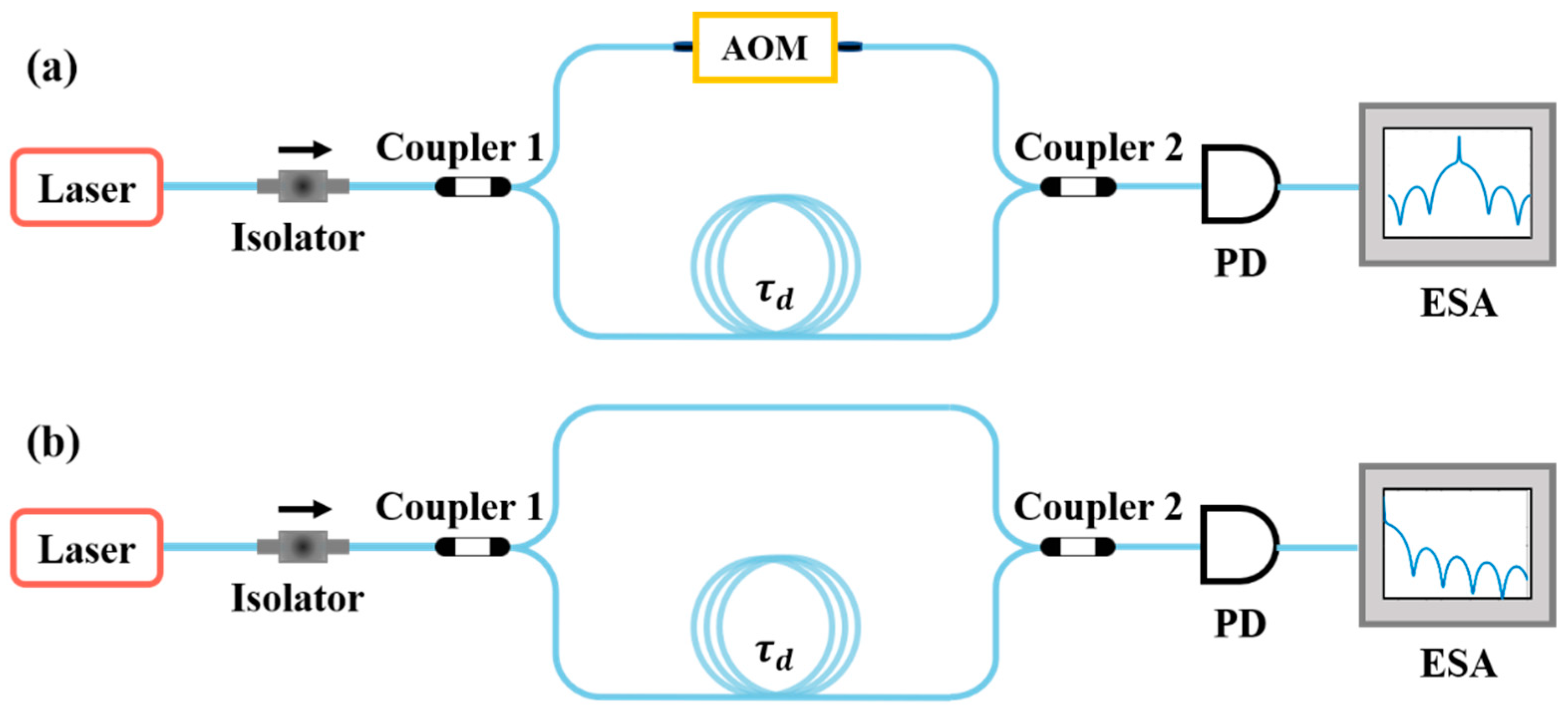
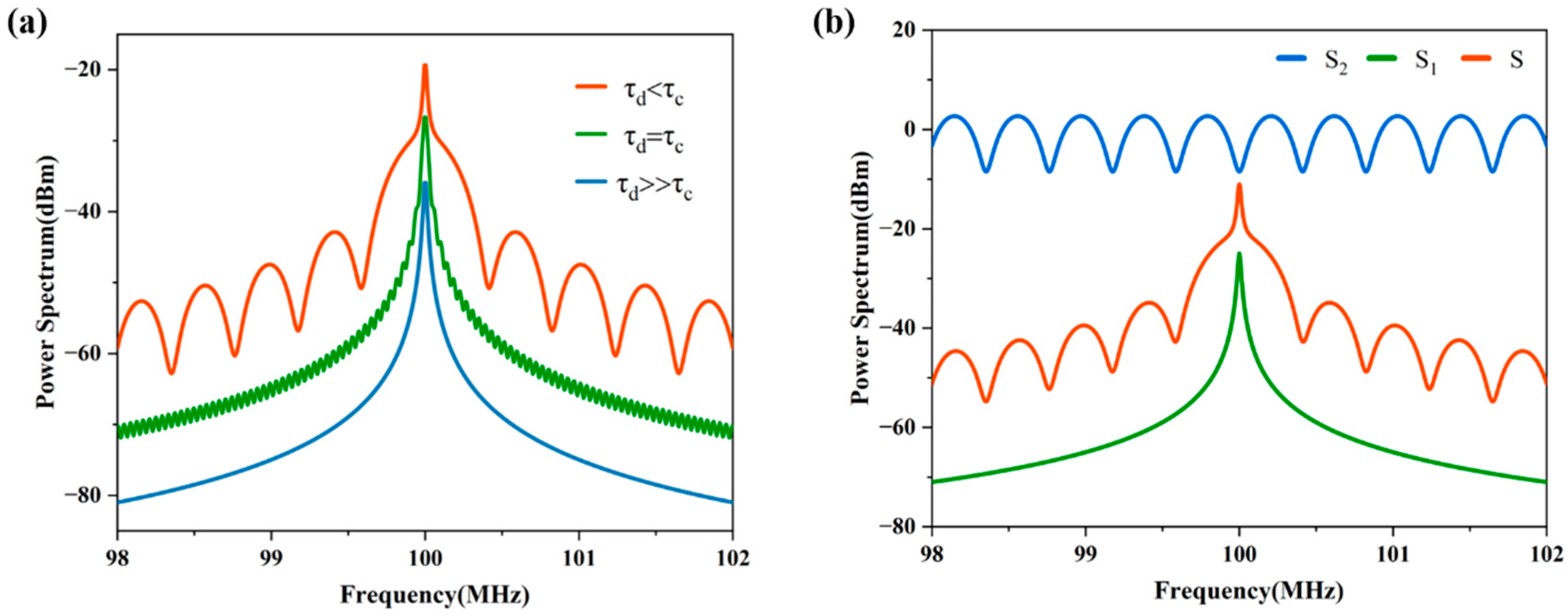
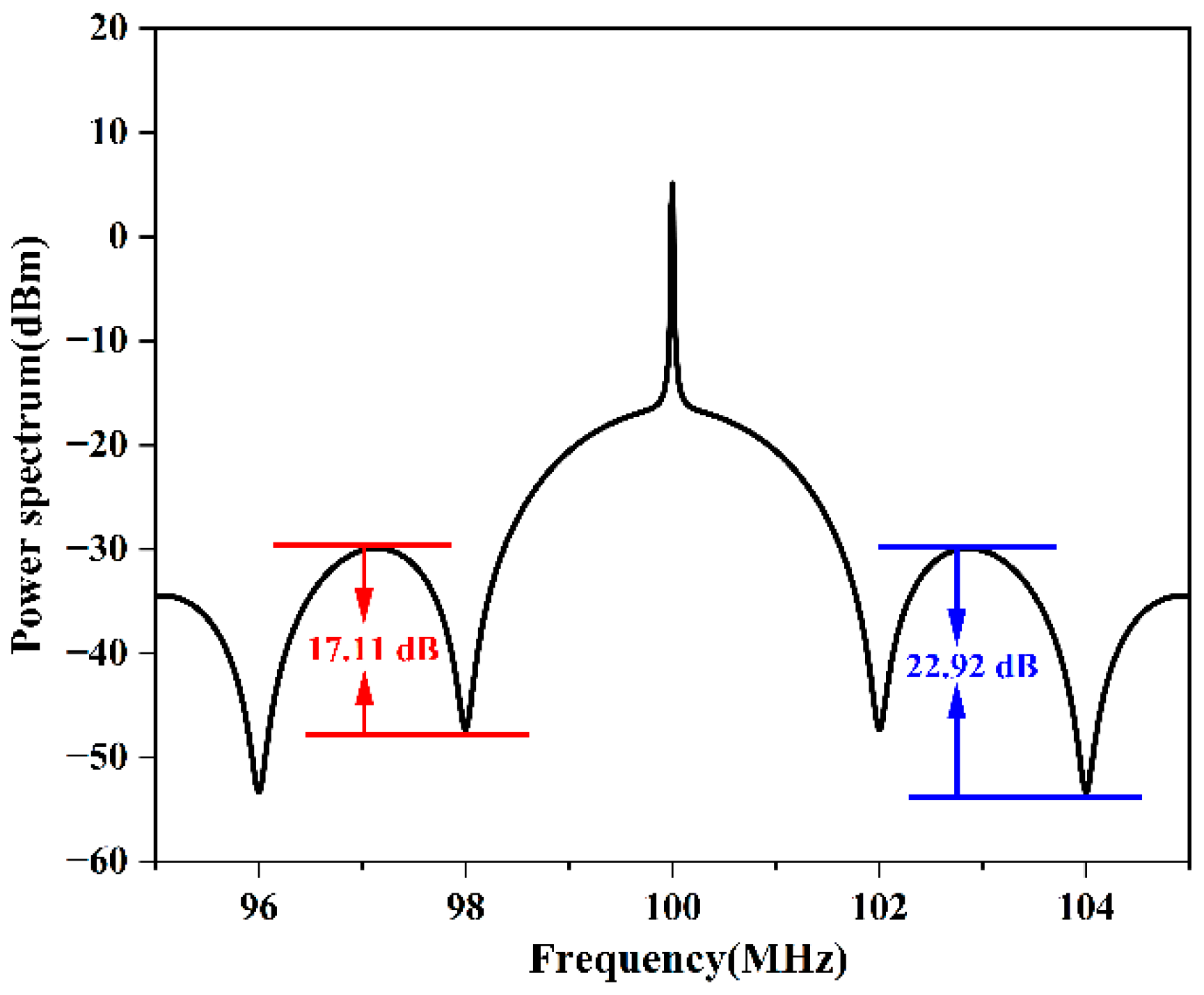
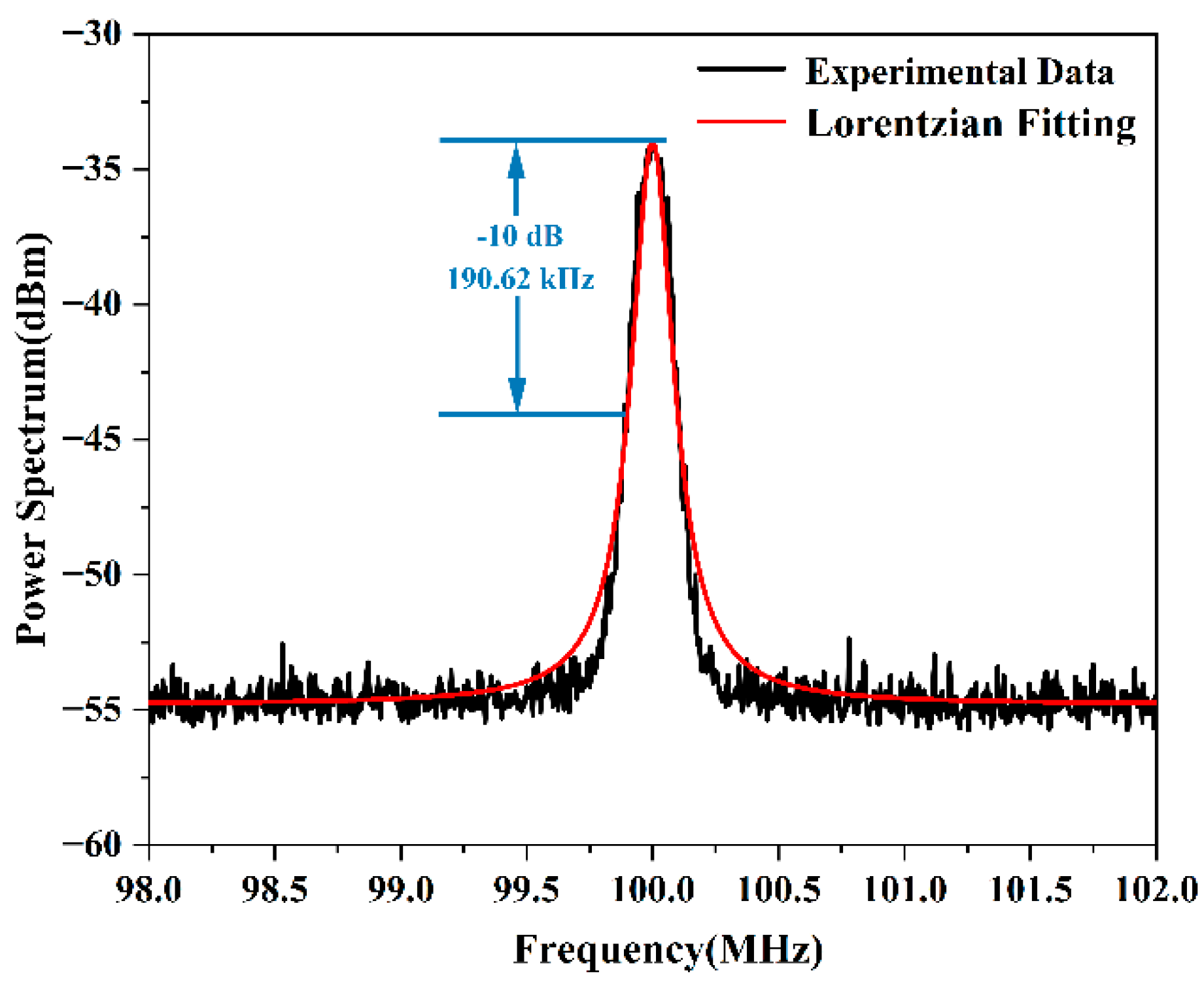
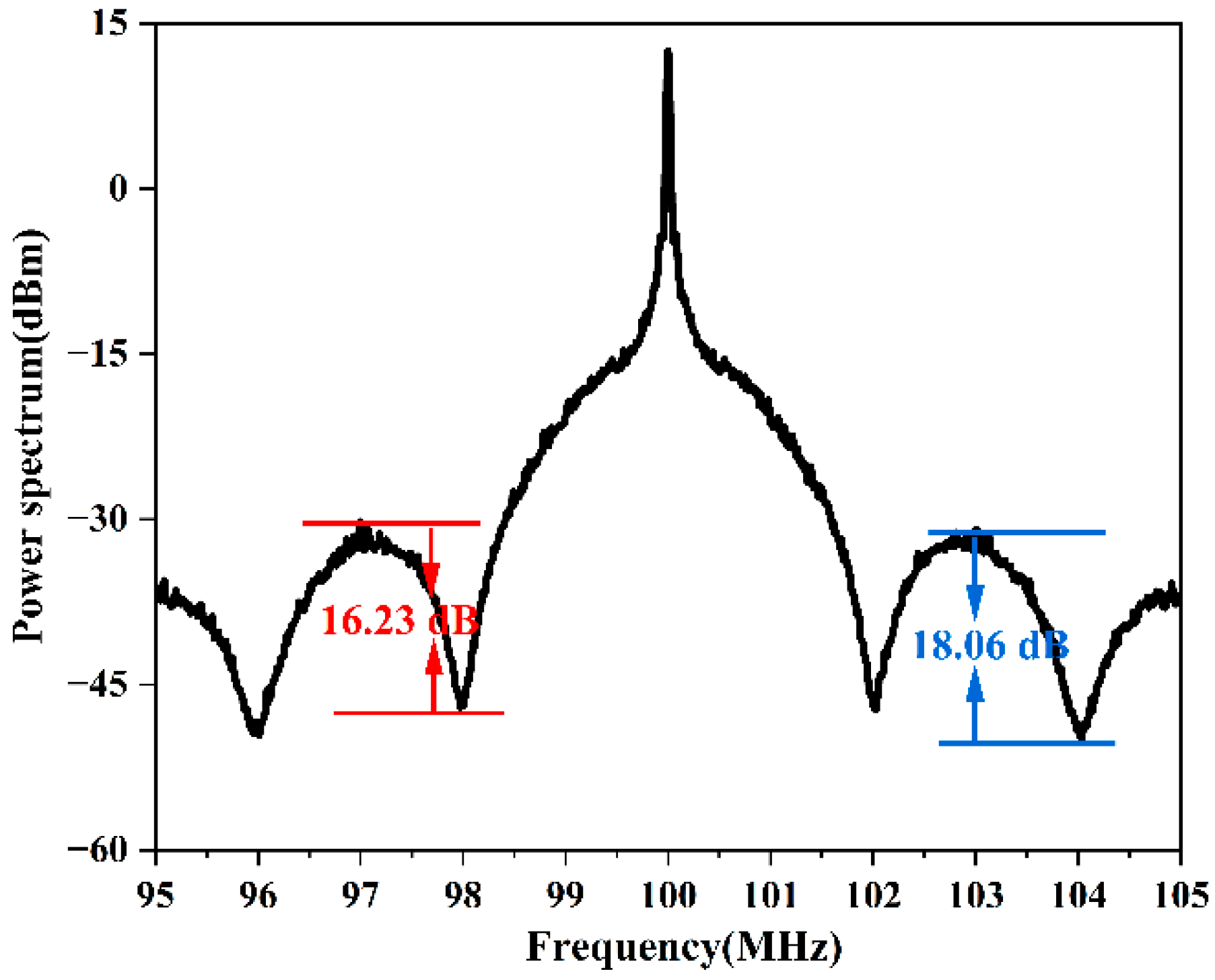
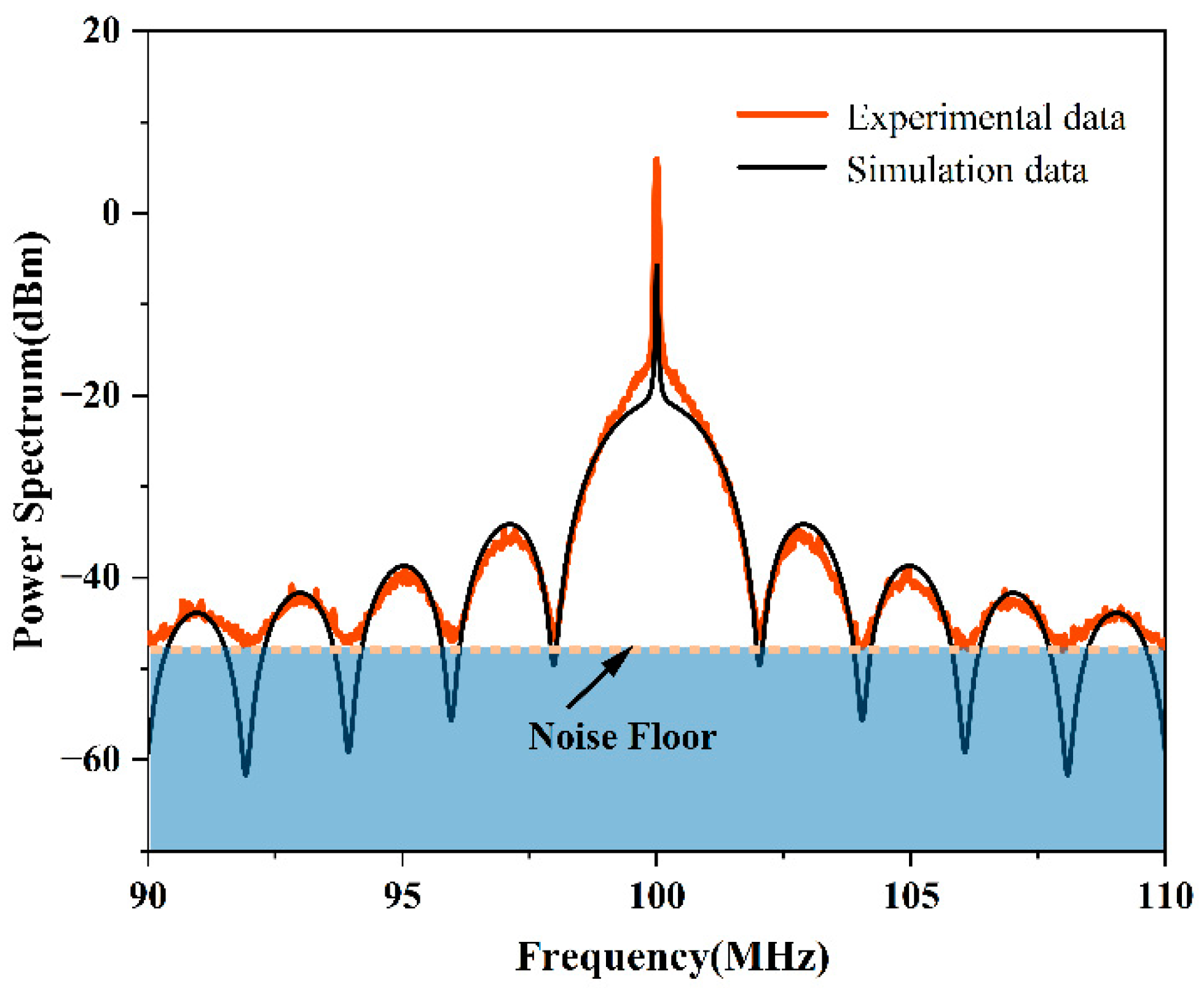
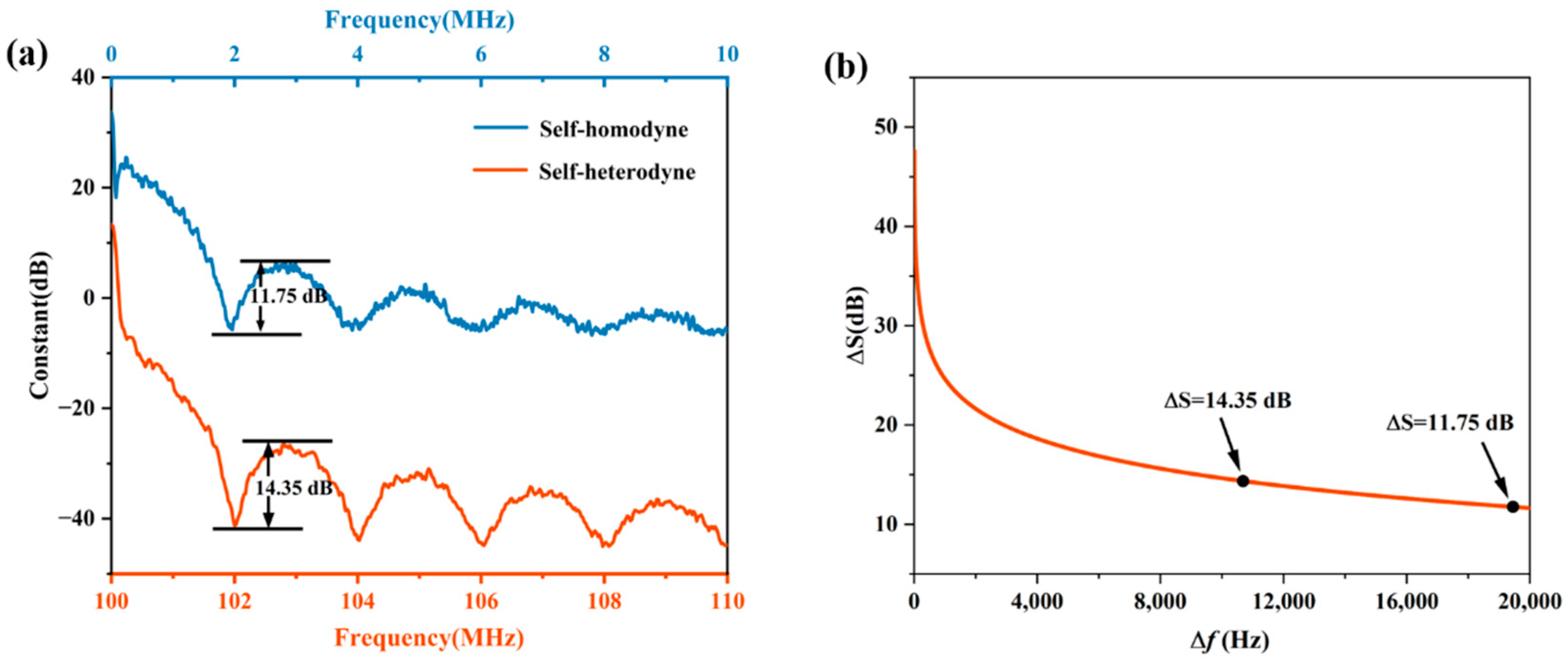
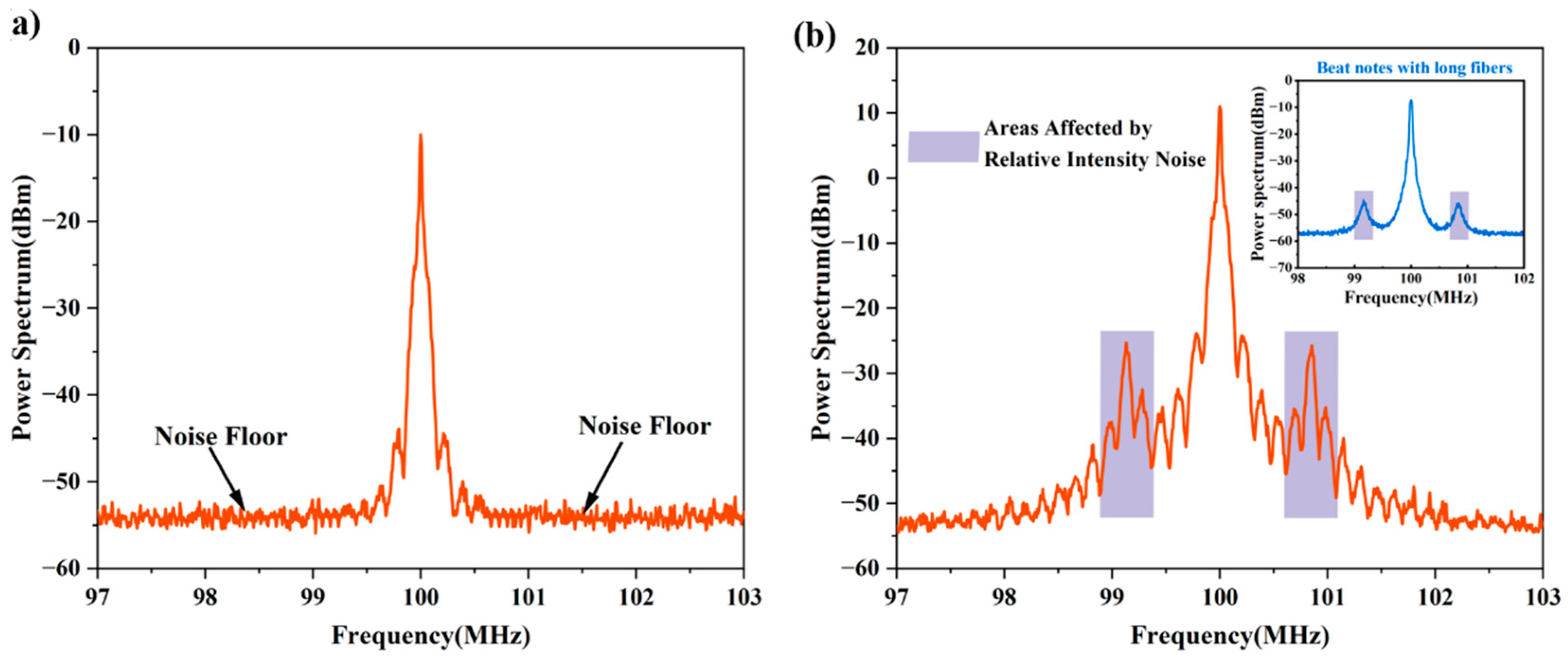
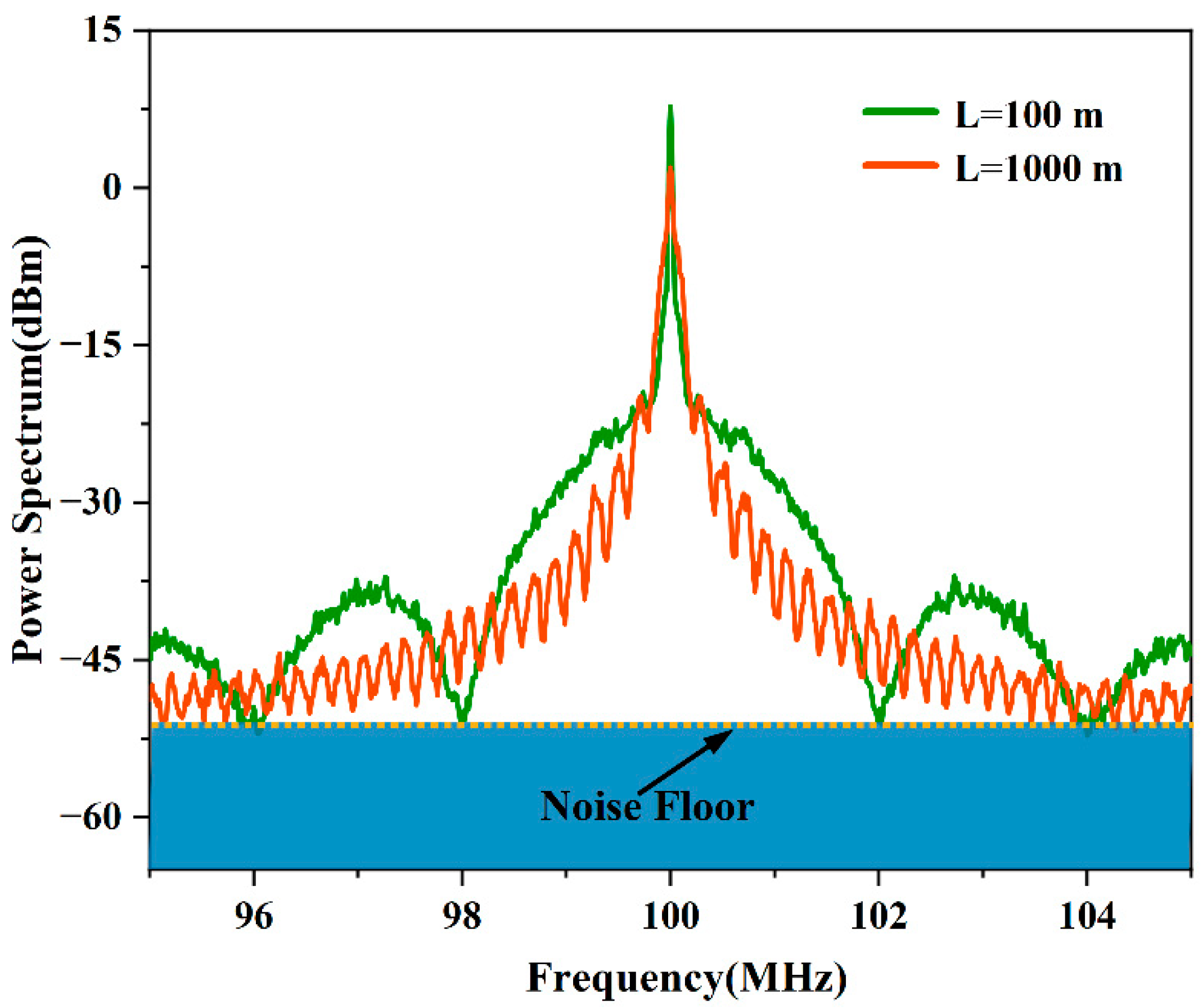
| m | k | ||
|---|---|---|---|
| 1 | 0 | 17.11 | 5.504 |
| 1 | 2 | 22.92 | 5.502 |
| m | k | ||
|---|---|---|---|
| 1 | 0 | 16.23 | 6.610 |
| 1 | 2 | 18.06 | 17.340 |
Publisher’s Note: MDPI stays neutral with regard to jurisdictional claims in published maps and institutional affiliations. |
© 2022 by the authors. Licensee MDPI, Basel, Switzerland. This article is an open access article distributed under the terms and conditions of the Creative Commons Attribution (CC BY) license (https://creativecommons.org/licenses/by/4.0/).
Share and Cite
Zhao, Z.; Bai, Z.; Jin, D.; Chen, X.; Qi, Y.; Ding, J.; Yan, B.; Wang, Y.; Lu, Z.; Mildren, R.P. The Influence of Noise Floor on the Measurement of Laser Linewidth Using Short-Delay-Length Self-Heterodyne/Homodyne Techniques. Micromachines 2022, 13, 1311. https://doi.org/10.3390/mi13081311
Zhao Z, Bai Z, Jin D, Chen X, Qi Y, Ding J, Yan B, Wang Y, Lu Z, Mildren RP. The Influence of Noise Floor on the Measurement of Laser Linewidth Using Short-Delay-Length Self-Heterodyne/Homodyne Techniques. Micromachines. 2022; 13(8):1311. https://doi.org/10.3390/mi13081311
Chicago/Turabian StyleZhao, Zhongan, Zhenxu Bai, Duo Jin, Xiaojing Chen, Yaoyao Qi, Jie Ding, Bingzheng Yan, Yulei Wang, Zhiwei Lu, and Richard P. Mildren. 2022. "The Influence of Noise Floor on the Measurement of Laser Linewidth Using Short-Delay-Length Self-Heterodyne/Homodyne Techniques" Micromachines 13, no. 8: 1311. https://doi.org/10.3390/mi13081311
APA StyleZhao, Z., Bai, Z., Jin, D., Chen, X., Qi, Y., Ding, J., Yan, B., Wang, Y., Lu, Z., & Mildren, R. P. (2022). The Influence of Noise Floor on the Measurement of Laser Linewidth Using Short-Delay-Length Self-Heterodyne/Homodyne Techniques. Micromachines, 13(8), 1311. https://doi.org/10.3390/mi13081311









